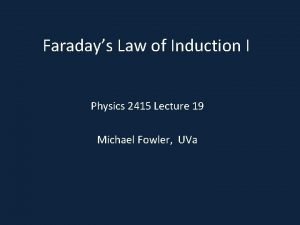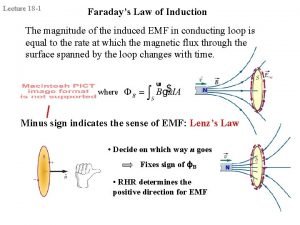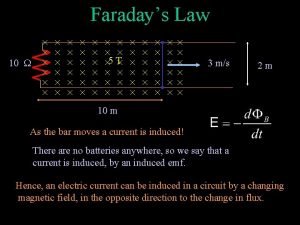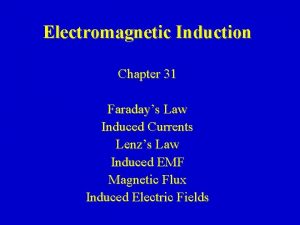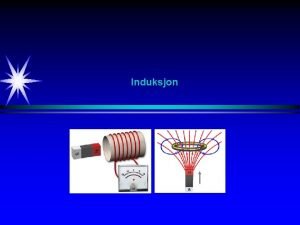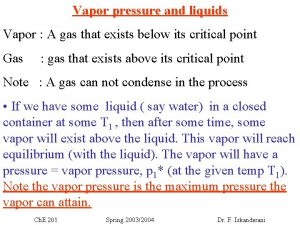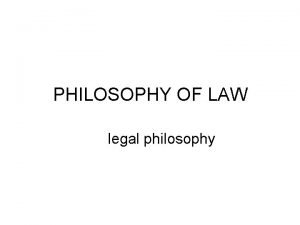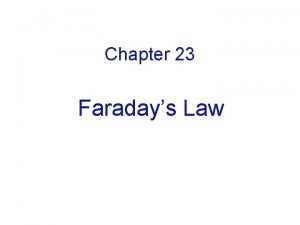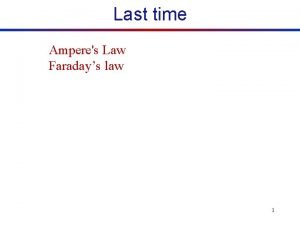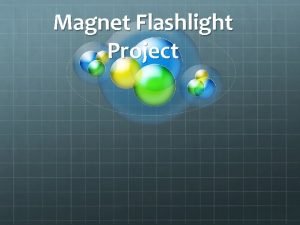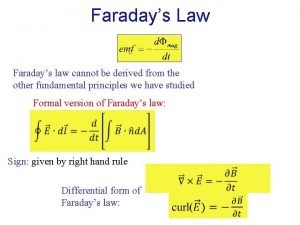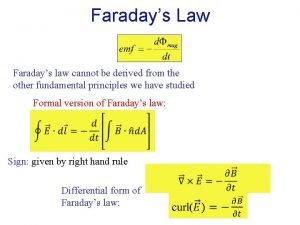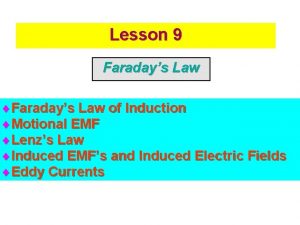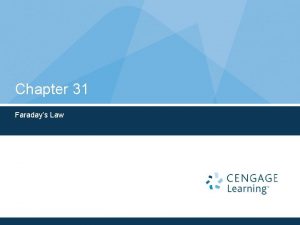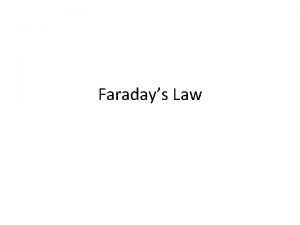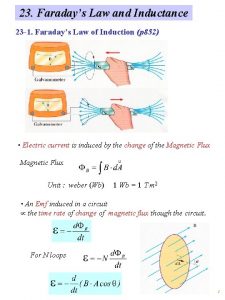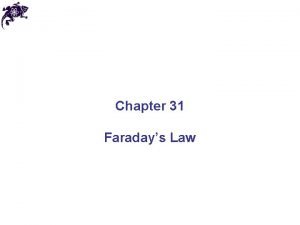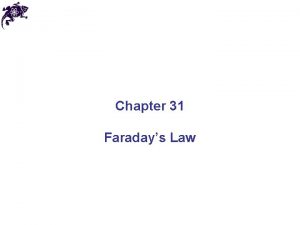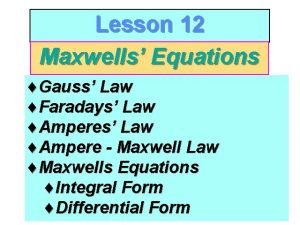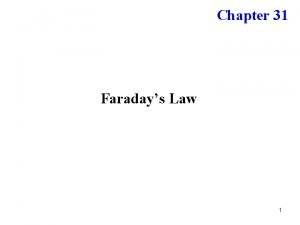Faradays Law 10 5 T 3 ms 2














- Slides: 14

Faraday’s Law 10 5 T 3 m/s 2 m 10 m As the bar moves a current is induced! There are no batteries anywhere, so we say that a current is induced, by an induced emf. Hence, an electric current can be induced in a circuit by a changing magnetic field, in the opposite direction to the change in flux.

Generality of Faraday’s Law • Faraday’s law applies when moving a wire in a magnetic field However, changing magnetic fields also produce an EMF. What is the nature of the force? It is not a magnetic force because the charges are not necessarily moving Changing magnetic fields must produce electric fields!

Faraday’s Law and Electric Fields q

Faraday’s Law and Electric Fields . A cylindrical region of radius R = 3. 0 cm contains a uniform magnetic field parallel to its axis. The field is 0 outside the cylinder. If the field is changing at the rate 0. 60 T/s, the electric field induced at a point 2 R from the cylinder axis is: Using Faraday’s law: 2 (2 R)E =- (R 2) d. B/dt, so E= (-(R 2) /4) d. B/dt=0. 0045 V/m

Comparision of Induction • No magnetic monopole, hence no magnetic current • Electric fields and magnetic fields induce in opposite fashions


What is the combined resistance of the mess at right? A) 1. 5 k B) 12 k C) 14 k D) 21 k 9 k 3 k 6 k 2 k 3 k

A Multiloop Circuit I 1 + I 3 = I 2 1. 5 – 3 I 2 = 0 9 – 5 I 1 – 3 I 2 = 0 I 2 = 1. 5/3 = 0. 5 A I 1 – + 9 V 5 I 2 3 I 3 1. 5 V – + What is the voltage loop rule What is the conservation of you get applied to the upper current law associated with I 1 = (9 – 3 I 2)/5 = 1. 5 A loop? the junction on the right? A) A) 9 + 5 I I 1 + I 21 = I + 3 I 3 2 = 0 I 3 = I 2 – I 1 = 0. 5 – 1. 5 = – 1 A B) B) 9 + 5 I I 1 + I 1 3 = I – 3 I 22 = 0 C) C) 9 – 5 I I 2 + I 1 3 = I + 3 I 12 = 0 D) D) 9 – 5 I I 1 + I 21 + I – 3 I 3 = 0 2 = 0

Odd Circuit What is the current through the resistor? A) 3. 6 A B) 1. 8 A C) 90 A D) 0 A – + 9 V 5 9 V – +

Four circuits have the form shown in the diagram. The capacitor is initially uncharged and the switch S is open. The values of the emf , resistance R, and the capacitance C for each of the circuits are circuit 1: 18 V, R = 3 , C = 1 µF � �circuit 2: 18 V, R = 6 , C = 9 µF �circuit 3: 12 V, R = 1 , C = 7 µF �circuit 4: 10 V, R = 5 , C = 7 µF Which circuit has the largest current right after the switch is closed? Which circuit takes the longest time to charge the capacitor to ½ its final charge? Which circuit takes the least amount of time to charge the capacitor to ½ its final charge?


Torque on a Loop B = 1 T 2 cm I = 1 A What is the torque on the wire? A) 4 10 -2 N m D) 10 -4 N m B) 10 -2 N m C) 4 10 -4 N m Which direction does the torque twist the loop? A) Right towards, left away B) Right away, left towards C) Top towards, bottom away D) Bottom towards, top away

Quiz: Ampere’s Law • Consider three wires with current flowing in/out as shown • Consider three different loops surrounding the wires X Y Which of the loops has the largest and smallest integrals of the magnetic field around the loops drawn? A) X > Y > Z C) Y > Z > X B) X > Z > Y D) Y > X > Z 2 A 3 A 1 A Z

Quiz A) Remains the same B) Reverses C) Changes in magnitude but not direction D) Changes to some other direction
 Faraday law
Faraday law Faraday's law of induction
Faraday's law of induction Faraday's law
Faraday's law Chapter 31 faraday law ofinduction
Chapter 31 faraday law ofinduction Faradays contant
Faradays contant Magneten fluks
Magneten fluks Newton's first law and second law and third law
Newton's first law and second law and third law Si unit of newton's first law
Si unit of newton's first law Boyle's law charles law avogadro's law
Boyle's law charles law avogadro's law P=k/v
P=k/v Raoult's law and dalton's law
Raoult's law and dalton's law Difference between civil law and criminal law
Difference between civil law and criminal law Positive law vs natural law
Positive law vs natural law Positive law vs natural law
Positive law vs natural law Natural law vs positive law
Natural law vs positive law
